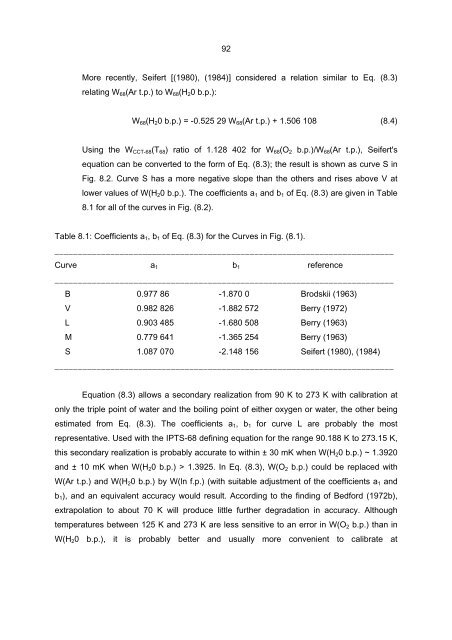techniques for approximating the international temperature ... - BIPM
techniques for approximating the international temperature ... - BIPM
techniques for approximating the international temperature ... - BIPM
Create successful ePaper yourself
Turn your PDF publications into a flip-book with our unique Google optimized e-Paper software.
92<br />
More recently, Seifert [(1980), (1984)] considered a relation similar to Eq. (8.3)<br />
relating W68(Ar t.p.) to W68(H20 b.p.):<br />
W68(H20 b.p.) = -0.525 29 W68(Ar t.p.) + 1.506 108 (8.4)<br />
Using <strong>the</strong> WCCT-68(T68) ratio of 1.128 402 <strong>for</strong> W68(O2 b.p.)/W68(Ar t.p.), Seifert's<br />
equation can be converted to <strong>the</strong> <strong>for</strong>m of Eq. (8.3); <strong>the</strong> result is shown as curve S in<br />
Fig. 8.2. Curve S has a more negative slope than <strong>the</strong> o<strong>the</strong>rs and rises above V at<br />
lower values of W(H20 b.p.). The coefficients a1 and b1 of Eq. (8.3) are given in Table<br />
8.1 <strong>for</strong> all of <strong>the</strong> curves in Fig. (8.2).<br />
Table 8.1: Coefficients a1, b1 of Eq. (8.3) <strong>for</strong> <strong>the</strong> Curves in Fig. (8.1).<br />
_________________________________________________________________________<br />
Curve a1 b1 reference<br />
_________________________________________________________________________<br />
B 0.977 86 -1.870 0 Brodskii (1963)<br />
V 0.982 826 -1.882 572 Berry (1972)<br />
L 0.903 485 -1.680 508 Berry (1963)<br />
M 0.779 641 -1.365 254 Berry (1963)<br />
S 1.087 070 -2.148 156 Seifert (1980), (1984)<br />
_________________________________________________________________________<br />
Equation (8.3) allows a secondary realization from 90 K to 273 K with calibration at<br />
only <strong>the</strong> triple point of water and <strong>the</strong> boiling point of ei<strong>the</strong>r oxygen or water, <strong>the</strong> o<strong>the</strong>r being<br />
estimated from Eq. (8.3). The coefficients a1, b1 <strong>for</strong> curve L are probably <strong>the</strong> most<br />
representative. Used with <strong>the</strong> IPTS-68 defining equation <strong>for</strong> <strong>the</strong> range 90.188 K to 273.15 K,<br />
this secondary realization is probably accurate to within ± 30 mK when W(H20 b.p.) ~ 1.3920<br />
and ± 10 mK when W(H20 b.p.) > 1.3925. In Eq. (8.3), W(O2 b.p.) could be replaced with<br />
W(Ar t.p.) and W(H20 b.p.) by W(ln f.p.) (with suitable adjustment of <strong>the</strong> coefficients a1 and<br />
b1), and an equivalent accuracy would result. According to <strong>the</strong> finding of Bed<strong>for</strong>d (1972b),<br />
extrapolation to about 70 K will produce little fur<strong>the</strong>r degradation in accuracy. Although<br />
<strong>temperature</strong>s between 125 K and 273 K are less sensitive to an error in W(O2 b.p.) than in<br />
W(H20 b.p.), it is probably better and usually more convenient to calibrate at
















